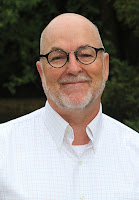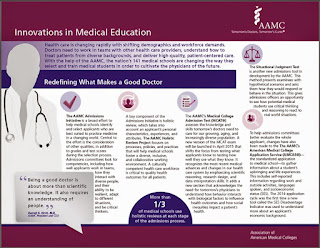Shared Discovery Brings First-Year Students Into The Clinic, Marking A Milestone for CHM
One of the biggest takeaways of the new Shared Discovery Curriculum is that it quickly places students inside clinics to contribute to real patient care teams. By quickly, we mean the first year.
Within weeks, actually.
While this is only one facet of the new curriculum, rapidly immersing students in real clinical environments is a big departure from traditional models.
Medical schools have delivered their curriculum by way of a "2 + 2" structure for decades. The first two years are predominantly dedicated to learning basic and disease sciences (typically delivered through lectures and numerous exams) followed by two years dedicated to clinical experiences that use observational and apprenticeship methods for learning.
With the Shared Discovery Curriculum now in it's second year, each of the college's last two entering classes have joined third- and fourth-year students in the clinic, providing a more authentic trajectory of training focused on progressively increasing responsibilities.
"This is a milestone for CHM because it is the first time in our history that all four classes of medical students have clinical placements in health care settings," says Brian Mavis, Director of the Shared Discovery Curriculum Academy.
First-year students are placed in over 90 outpatient sites around Grand Rapids and East Lansing, according to Mavis, while second-year clinical rotations involve tremendous coordination with over
40 sites.
Those rotations include physical therapy, emergency medicine, nutrition consultation service, ambulatory obstetrics and gynecology, adult wards, pharmacy service, pediatric wards, newborn nursery, respiratory therapy, social work, and palliative care.
"Interprofessional education is a current hot topic in medical student education and we are redefining what it means to have meaningful experiences across the health professions. All of this is new these past two years and complements our long-standing community-integrated clerkships for third- and fourth-year students in 70 clinical sites located within seven community campuses across Michigan," explains Mavis.
Shared Discovery removes the barriers between learning the sciences and training to provide care. So just as important in the curriculum to where students are training is how. Hands-on experience in the clinic is combined with post-clinic debriefing, problem-based learning and other small group learning initiatives, student portfolio review and individual learning plan formulation and tracking.
The curriculum centers around early and ongoing clinical experiences organized in three major segments: the Early Clinical Experience (ECE) in the first year, the Middle Clinical Experience (MCE) in the second year and the Late Clinical Experience (LCE) makes up the final two years.
Progressing through each stage of clinical experience, the curriculum does away with traditional lectures and instead blends intimate learning with action, facilitating adult learning. The intention is to employ a better, more modern way of preparing CHM students for residency and beyond.
"For the first time, CHM has over 800 students across Michigan with meaningful engagement in health care delivery. It is by any measure an amazing accomplishment, and continues our legacy of educational innovation."
Official Shared Discovery Curriculum Folio
Within weeks, actually.
While this is only one facet of the new curriculum, rapidly immersing students in real clinical environments is a big departure from traditional models.
Medical schools have delivered their curriculum by way of a "2 + 2" structure for decades. The first two years are predominantly dedicated to learning basic and disease sciences (typically delivered through lectures and numerous exams) followed by two years dedicated to clinical experiences that use observational and apprenticeship methods for learning.
With the Shared Discovery Curriculum now in it's second year, each of the college's last two entering classes have joined third- and fourth-year students in the clinic, providing a more authentic trajectory of training focused on progressively increasing responsibilities.
"This is a milestone for CHM because it is the first time in our history that all four classes of medical students have clinical placements in health care settings," says Brian Mavis, Director of the Shared Discovery Curriculum Academy.
 |
| Brian Mavis, PhD, Director of SDC Academy |
40 sites.
Those rotations include physical therapy, emergency medicine, nutrition consultation service, ambulatory obstetrics and gynecology, adult wards, pharmacy service, pediatric wards, newborn nursery, respiratory therapy, social work, and palliative care.
"Interprofessional education is a current hot topic in medical student education and we are redefining what it means to have meaningful experiences across the health professions. All of this is new these past two years and complements our long-standing community-integrated clerkships for third- and fourth-year students in 70 clinical sites located within seven community campuses across Michigan," explains Mavis.
Shared Discovery removes the barriers between learning the sciences and training to provide care. So just as important in the curriculum to where students are training is how. Hands-on experience in the clinic is combined with post-clinic debriefing, problem-based learning and other small group learning initiatives, student portfolio review and individual learning plan formulation and tracking.
The curriculum centers around early and ongoing clinical experiences organized in three major segments: the Early Clinical Experience (ECE) in the first year, the Middle Clinical Experience (MCE) in the second year and the Late Clinical Experience (LCE) makes up the final two years.
Progressing through each stage of clinical experience, the curriculum does away with traditional lectures and instead blends intimate learning with action, facilitating adult learning. The intention is to employ a better, more modern way of preparing CHM students for residency and beyond.
"For the first time, CHM has over 800 students across Michigan with meaningful engagement in health care delivery. It is by any measure an amazing accomplishment, and continues our legacy of educational innovation."
Official Shared Discovery Curriculum Folio




Comments
Post a Comment